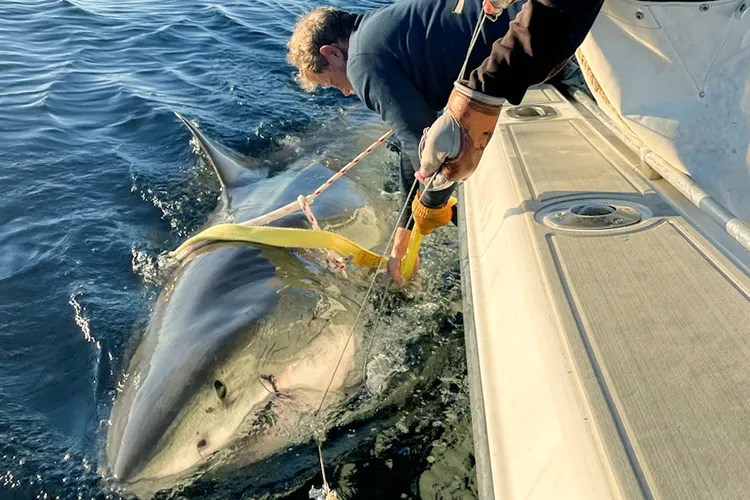
Pic Credit: OCEARCH
In mid-July 2025, the North Atlantic made headlines with the stunning resurgence of “Contender”, a colossal great white shark currently recognized as the largest male ever tagged in the Atlantic Ocean. Measuring approximately 13 feet 9 inches and tipping the scales at an astounding 1,653 pounds, Contender’s journey has captivated scientists and the public alike.
Tagged by the marine research nonprofit OCEARCH off the Florida‑Georgia coast in January 2025, Contender has become a living data stream, pinging its location across the eastern seaboard via a SPOT satellite tag. Each ping—registered whenever the shark’s dorsal fin breaches the surface—provides critical insight into its migration patterns. The tag is expected to yield valuable real-time data for up to five years.
A Journey Through the Atlantic
Since its initial tagging, Contender has traveled over 1,000 miles north, surfacing near Cape Hatteras, then moving steadily toward New England waters. On July 18, the shark was detected about 50 miles off the coast of Nantucket, between Nantucket Shoals and Georges Bank—a region frequented by tourists in summer (Hudson Valley Post).
This movement is part of a well-known seasonal migration: great whites head north in warmer months to feed and avoid high temperatures, before returning south as autumn approaches. These patterns are consistent year after year thanks to predictable prey availability and water temperatures.
Contender’s presence in New England coincides with a notable uptick in shark activity. The Atlantic White Shark Conservancy, along with local authorities, has recorded numerous sightings off Cape Cod, Chatham, and even in Gulf of Maine waters. On July 15 alone, alerts from Chatham noted a great white shark spotted just 40 feet off North Beach Island, prompting public advisories via the Sharktivity app.
Why Contender Stands Out
While Contender holds the record for the largest tagged male great white in the Atlantic, it is not the absolute largest ever documented. Other Atlantic males, such as “Hagans” (15 feet) and the female “Large Marge” (18 feet), have been measured even larger. In the broader oceanic context, the Pacific’s “Deep Blue” (estimated at 20 feet or more) remains crown jewel of size among white sharks.
Still, Contender is unique. Experts have labeled him a true ocean giant, notable not just for bulk but for pushing biological norms: males rarely exceed 12 feet, yet here he is, nearly 14 feet of apex predator prowess.
Implications for Science and Safety
Beyond the awe factor, Contender’s migration tracking provides researchers with invaluable data on great white behavior. OCEARCH has also collected urogenital and other biological samples, enabling deeper analysis of genetics, physiology, and age—the shark is estimated to be around 32 years old.
These efforts help better understand shark life cycles, population health, and interaction with human coastal zones. Crucially, by following tagged sharks in real time, authorities can improve public education and coastal safety without resorting to fear or sensationalism—reducing the risk of dramatic scenarios like those in “Jaws”.
What Coastal Communities Should Know
Despite its immense size, Contender does not pose a direct threat to humans, especially since it tends to stay offshore. Great whites are drawn by seal-rich areas and feed primarily on marine mammals. Nevertheless, locals and tourists are urged to remain Shark Smart:
- Stay informed via apps such as the Sharktivity app, used widely by the Atlantic White Shark Conservancy to confirm sightings
- Avoid swimming far from shore, particularly near seal haul-outs and in known shark migration route.
- Pay attention to public advisories—beaches near Bailey Island, Maine recently issued warnings after multiple shark sightings within 48 hours, though remained open (New York Post)
Conservation as Success
The abundance of sightings—from Cape Cod to Maine—is a direct payoff of decades-long marine conservation. Seal populations have rebounded thanks to protective legislation, and great whites have returned to areas they previously vacated due to overfishing. In Maine alone, researchers recorded over 100 individual great whites via acoustic arrays between 2012 and 2023 (National Geographic).
The Contender story demonstrates how science, technology, and policy can converge to promote coexistence with one of the ocean’s most formidable apex predators.
In Summary:
Contender’s journey offers a glimpse into the deep mysteries of marine life. At nearly 14 feet long and more than 1,650 pounds, this giant not only charts known shark territory but expands our understanding of what wild great whites can be. And while it’s a thrilling ride for scientists and enthusiasts alike, it’s also a reminder: you don’t need to encounter the biggest shark in the sea to be awed by the natural world—and to respect it.






